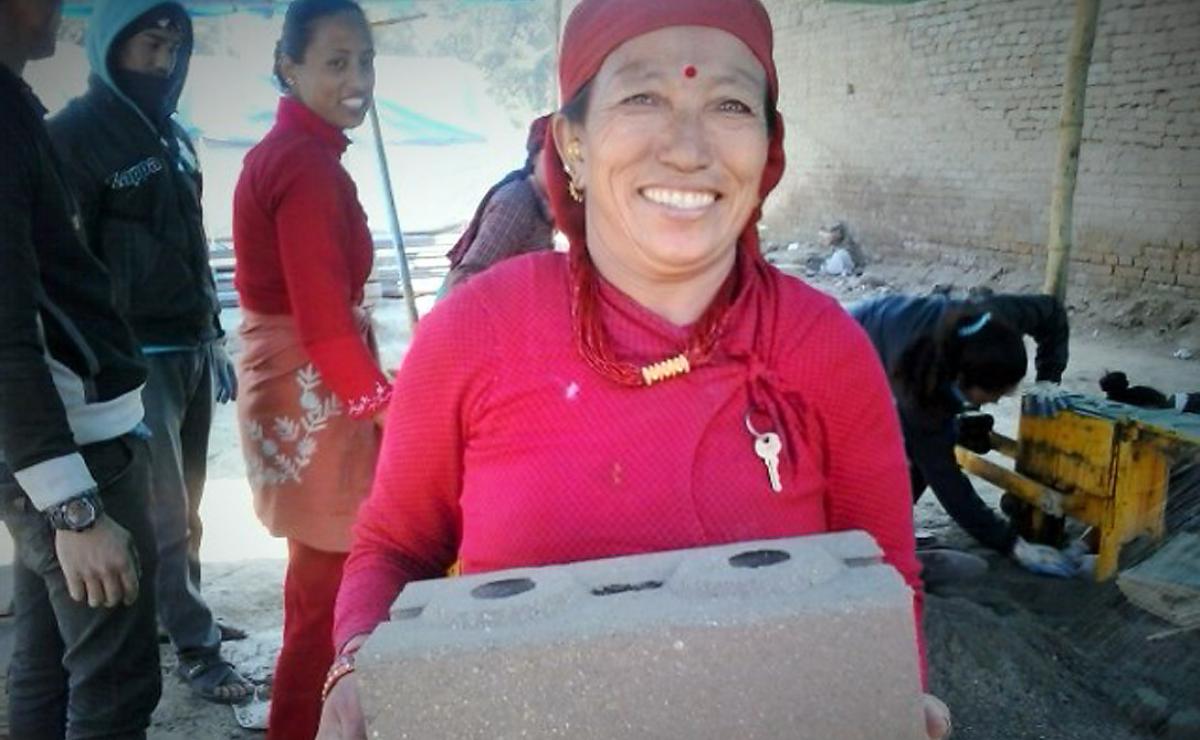Brick by brick, earthquake survivors rebuild their homes

Nepal: Reconstruction starts in model villages
(LW) - It takes a village to rebuild one. Almost nine months after the earthquake that destroyed 600,000 buildings in Nepal, the people of Sanogoan village have joined hands to rebuild their homes. The Lutheran World Federation (LWF) Nepal, in collaboration with the ACT Nepal Forum, recently deposited money in the bank accounts of 90 families from the village for this purpose.
The reconstruction of homes in Nepal has been delayed by a political crisis that followed the adoption of a new constitution last September. While Nepal’s political crisis drags on, the people of Sanogoan have little time to talk politics: they are busy making bricks.
Sanogoan is a traditional settlement at the edge of Kathmandu Valley, inhabited by the Newar people. Badly hit by the April 2015 earthquake, the town now looks like a tented camp. Dozens of tunnel-shaped white tents are placed in neat rows, with solar lights hanging from the roofs. There is a lot of talking and laughter as a group of women has started making building materials in the center of the village. Sand is sifted and mixed with cement and gravel. The mix is poured into a mold after which it is pressed down. The large bricks are then carried into the sun to dry for a few weeks.
The tight-knit community of the Newar plans to rebuild 90 destroyed farm houses, taking turn by groups of villagers. The first bricks go to the most vulnerable family, whose home will act as a model house.
Hope after years of despair
One of brick makers is Kabita Shrestha. Dressed in a colorful blouse, with a purple shawl tucked around her pink sari, Shrestha looks as if she doesn't have a care. However, the 26-year-old has seen her share of difficulty. Having lost her mother at a young age, Shrestha did not have a chance to study or marry. Instead she took care of her younger brother and sick father. Last year Shrestha injured her leg and lost all personal belongings when her home collapsed during the earthquake.
Shrestha’s suffering did not end there. Her brother, who used to work as a driver, lost his job after the earthquake. His wife was pregnant. And Shrestha’s father’s medical condition worsened. More and more she was struggling to meet the needs of her family.
It took close to nine months for Shrestha to feel some relief. Her family was one of the recipients of funds from the LWF Nepal to build a new home. The first installment is 200,000 Nepali rupees (1915USD) to build a new home. This was deposited in her family’s newly-opened bank account. “I never had as much as 10,000 rupees in my hands. I cannot even imagine what 200,000 rupees looks like,” Shrestha said.
The bank deposit was a long-awaited step in a unique program developed for Sanogoan and nearby village, Nanglebhare, acting as ‘model villages’ for the re-buildinging of affected communities. LWF Nepal’s connection with Sanogoan dates back from a week after the earthquake, when country director Prabin Manandhar received a phone call. “You are taking relief materials to remote villages, but no one is helping us here, just 20 kilometers from Kathmandu,” the caller said. LWF Nepal, in collaboration with ACT Nepal Forum members, sent out an assessment team to see the situation for themselves. As their impressions confirmed the call to the LWF office, Manandhar immediately dispatched a team with relief materials and hired an emergency response officer to coordinate intervention.
Women lead the way
Nine months later, emergency response officer Madhu Sunam is still based in the village, now coordinating livelihood development and the reconstruction of homes. Carrying just a small rucksack ("my mobile office," he says), Sunam is constantly on the move. Living with the people in tents, she stays with each family for one or two nights at the time. “People invite me to stay longer, but I know that it is hard for them to accommodate me. So I keep moving,” she says.
Sunam enjoys her challenging job and has seen a major change among the women of Sanogoan. “When I first came women hardly spoke in meetings. They were used to doing household work and farming. The earthquake pushed them out of their comfort zone. The women are now quite vocal, and in many ways lead the efforts in reconstruction.”
LWF’s small business development program has further promoted women's empowerment. The community selected 16 candidates to develop a small venture with the support of 15,000 Nepali rupees. One of them is 19-year old Saru Shrestha. Born into a family of 10, Shrestha
had to leave school after the earthquake to help care for her younger brothers and sisters. Using the small grant, Shrestha established a shop selling tea, snacks and sweets. “At first it was hard, especially arguing with people who buy things on credit. But I feel less shy now,” says Shrestha, who uses most of the income to pay for school fees for her siblings. Some of it she sets apart. “My dream is to open a second shop, selling cosmetics,” says the young entrepreneur.
An exceptionally cold winter
While one of the women makes a round with a large kettle, pouring home-made chhyang, or rice beer, for the workers, Kabita prepares for a next round of brick making. “Life is still very difficult,” she says. “This is an exceptionally cold winter. I recently had to leave my comfortable tent to create space for the bricks to dry. We now live in a makeshift shelter behind the old house.”
Shrestha’s sister-in-law gave birth to a healthy girl two weeks ago but is forced to sleep on the floor in an unheated room. Shrestha's father recently had to be admitted in a hospital. His medication alone costs 10.000 Nepali Rupees per month. Because of a blockade in the south there is a shortage of kerosene and gas. Shrestha cooks on pieces of bamboo collected from a nearby forest.
Despite the countless problems, Shrestha feels a sense of hope. Together with her women friends, she sums up the parts that make up her dream house: “An inside toilet, a comfy kitchen with piped water and a rooftop for sun bathing and drying vegetables.”
If all goes well, Shrestha might be able to move into her dream house before the end the year.
Contribution by LWF correspondent Lucia de Vries, Nepal

